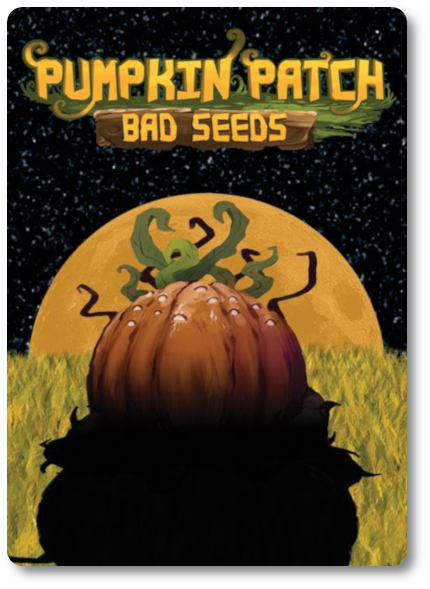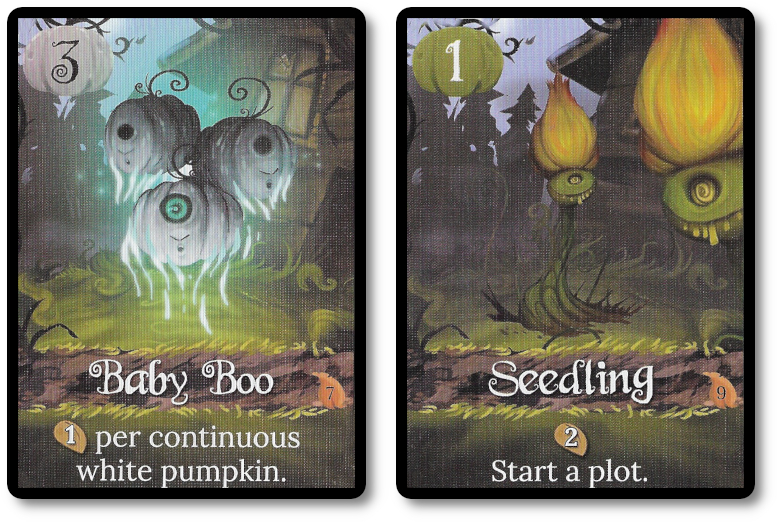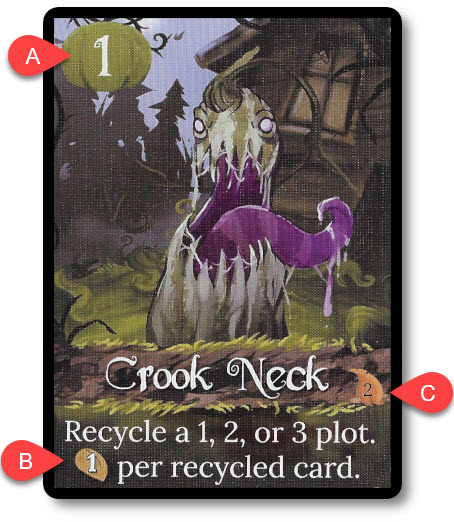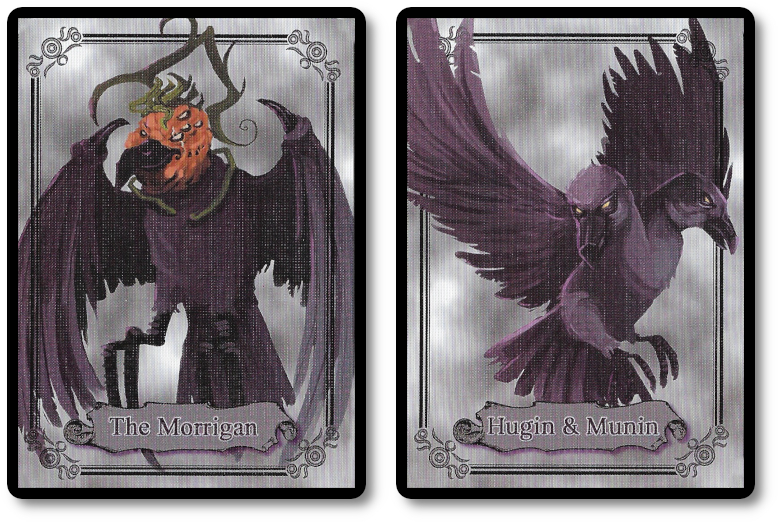
The Basics:
- For ages 10 and up (publisher suggests 14+ on the box and 8+ in the rule book)
- For 1 to 3 players
- Approximately 15 minutes to complete
Geek Skills:
- Counting & Math
- Logical & Critical Decision Making
- Reading
- Pattern/Color Matching
- Strategy & Tactics
- Risk vs. Reward
- Visuospatial Skills
- Hand/Resource Management
Learning Curve:
- Child – Easy
- Adult – Easy
Theme & Narrative:
- All that grows in warm earth is not wholesome
Endorsements:
- Gamer Geek mixed!
- Parent Geek mixed!
- Child Geek approved!
Overview
American author, journalist, activist, and the Lewis K. Chan Arts Lecturer and Professor of Practice of Non-Fiction at Harvard University, Michael Pollan, said “The garden suggests there might be a place where we can meet nature halfway.” But what if that garden is full of evil? How far would you want to meet something that isn’t in the mood to be picked, but is always hungry? Yikes.
Pumpkin Patch: Bad Seeds, designed by Travis Drake, Tim Eller and published by Brouhaha Games, is comprised of 44 Pumpkin cards, six Gourd Attack! cards, two Crow cards, one Scarecrow card, one Scoretrack card, and three Pumpkin Score markers. The cards are as thick and as durable as your standard playing card. The Pumpkin Score markers are in the shape of tiny pumpkins (in three different colors) that have been cut out, allowing the players to easily see the score value the marker is positioned to. Illustrations by Viktor Koch are outstanding, creating a nightmarish whimsy of a pumpkin patch for the players to frolic in. Although, based on how some of these pumpkins look (with evil haunting eyes and huge teeth), that isn’t such a good idea…
Please note that your game, if you choose to purchase it, will include the “Gourd Attack!” mini-expansion. Our copy, sadly, did not, even though the rule book suggested it should. That’s a bit misleading, eh? This mini-expansion and its rules are explained in detail, but since we didn’t have the components, we didn’t play it. As such, this review is only focuses on the base game.
Let’s Plant Some Seeds
To set up the game, first find a “Baby Boo” Pumpkin card and place it face-up in the center of the playing area. Then find four “Seedling” Pumpkin cards and place these cards face-up and surrounding the “Baby Boo” Pumpkin card on all four sides. These are referred to as “Plots”, as in the kind you plant to in a garden or a field.

Second, find and place the two Crow cards on two opposite plots on the left and right side of the “Baby Boo” Pumpkin card.
Third, find and place face-up one “Baby Boo” Pumpkin card, on top of that place three “Jack be Little” Pumpkin cards, and on top of that three “Seedling” Pumpkin cards. Place this pile of cards to one side of the cards previously placed. This pile is referred to as the “Compost”.
Fourth, shuffle the remaining cards and deal each player three cards, face-down. This is the player’s starting hand which should be kept hidden. Place the remaining deck of cards face-down next to the Compost pile. This is the draw deck for the duration of the game. Leave room for a discard pile.
Fifth, place the Scoretrack card to one side of the playing area and assign each player’s Pumpkin Score marker to the value of zero.
That’s it for game set up. Determine who will be the first player and begin.
How Does Your Evil Garden Grow?
Pumpkin Patch: Bad Seeds is played in turns with no set number of turns per game. On a player’s turn, they must complete four sequential actions. These actions and the order in which they must be completed are summarized here.
Action One: Play a Card and Score
The player must play a card either from their hand or the top-most card from the Compost pile. Once played, the card’s ability is immediately resolved before play continues. Any updates to the player’s score is also adjusted at this time. Scoring some cards is a bit more complex than just looking at the number on the card and adjusting the scoretrack. When scoring, look at all the face-up cards in the plots that are currently in play. For example, some cards score points based on the number of similar cards there are in a continuous group, which means how many cards of that color or value are currently showing. As such, adding cards to plots is an exercise in timing if players hope to score the big points.
There are a number of rules that must be observed when playing a card. But before we can even get into that, let’s take a look at what each card is telling the player.

A) Each Pumpkin card has a number value. Even-numbered cards have an orange pumpkin, odd-numbered are white, and some pumpkins are green, which indicates they have no color yet. The number value indicates the order in which they must be played, from lowest to highest in ascending order, with the higher number always covering a lower number value.
B) Each pumpkin type has a special ability. When the Pumpkin card is played, its ability is triggered and immediately resolved. The number value in the seed icon is the number of points the player scores for that specific card.
C) There are a limited number of pumpkins of each name in the game. The number available is listed. Handy for those players looking to count cards and to help keep track of what possible cards could be played as the game continues.
When playing a Pumpkin card, is must be played on top of another Pumpkin card with a number value one less than the one being shown on the card to be played.
Any “Plot” Pumpkin cards (i.e. Seedlings), must be played orthogonally adjacent to another plot. This also influences how a plot can be moved during the game, always playing it orthogonally to another.
If the player does not have any cards in their hand and there are no more cards in the Compost pile, they skip to the Move the Crows action.
Action Two: Move the Crows
The player must now move one of the two Crow cards. If playing a two-player game, each player will be assigned a crow. If playing three players, any crow can be moved. Crow cards are moved to other plots and sit on top of the cards in that pile. Crows stop players from playing additional cards to it or moving the Plot. However, Crow cards do not block seed scoring.

Action Three: Discard
Any cards the player still has in their hand can now be discarded if the player thinks it’s advantageous to do so. Discarded cards go the discard pile. A player can, if they so choose, discard all remaining cards in their hand.
Action Four: Draw
The player now draws as many cards as needed from the draw deck to bring the total number of cards in hand to three. If the draw deck is depleted, shuffle the discard pile to form a new draw deck.
This completes the player’s turn. The next player in turn order sequence now takes their turn starting with the first action noted above.
Harvesting the Souls of Pumpkins
The game continues as summarized above, with players taking turns until the “Cinderella” Pumpkin card is played and scored for its seeds. The winner of the game is the player who has collected the most seeds. If there is a tie, victory goes to the player who played the “Cinderella” Pumpkin card.

Game Variants
As mentioned earlier in this review, there is a mini-expansion that supposedly comes with the game. If you play it, let us know how it goes.
There is also a solo variant available, which is played more or less the same, but the Crow cards have a mind of their own. An interesting exercise in problem solving and creative thinking for those who enjoy a good solitaire game.
To learn more about Pumpkin Patch: Bad Seeds, visit the game’s web page.
Final Word
 The Child Geeks had a good time with the game, finding the rules to be easy to grasp and the game play engaging. According to one Child Geek, “I like how the game is like a puzzle. You have to figure out how to best play your cards and when if you want to score big points, but there are always some points to be scored.” The Child Geek brings up a great point. Players score on what is currently available in the entire pumpkin patch in all the plots. Playing a card at the right time could give the player a lot of points or none, which might not sound great, but it also serves as a nasty way to block other players from scoring. Another Child Geek said, “I think the game is creepy fun!” Yes, this would make for an amusing game to play during Halloween. When all the votes were in, the Child Geeks agreed to fully approve it.
The Child Geeks had a good time with the game, finding the rules to be easy to grasp and the game play engaging. According to one Child Geek, “I like how the game is like a puzzle. You have to figure out how to best play your cards and when if you want to score big points, but there are always some points to be scored.” The Child Geek brings up a great point. Players score on what is currently available in the entire pumpkin patch in all the plots. Playing a card at the right time could give the player a lot of points or none, which might not sound great, but it also serves as a nasty way to block other players from scoring. Another Child Geek said, “I think the game is creepy fun!” Yes, this would make for an amusing game to play during Halloween. When all the votes were in, the Child Geeks agreed to fully approve it.
 The Parent Geeks found the game to be light and casual, with the only item of note to which they grumbled about was the number of players. According to one Parent Geek, “I like the game. Quick and easy to set up and fun to play. But why only up to three players? So much for playing this game on couples’ night.” And yet, the Parent Geeks were always eager to play, with one of their peers always having to sit out. This most certainly influenced the Parent Geek’s vote, but it must be noted that their disappointment was based on how much fun they were having, but at the cost of excluding others. As one Parent Geek put it, “I like the game, but hate how few people can play it.” When the votes were in, the Parent Geeks gave this little game a mixed endorsement.
The Parent Geeks found the game to be light and casual, with the only item of note to which they grumbled about was the number of players. According to one Parent Geek, “I like the game. Quick and easy to set up and fun to play. But why only up to three players? So much for playing this game on couples’ night.” And yet, the Parent Geeks were always eager to play, with one of their peers always having to sit out. This most certainly influenced the Parent Geek’s vote, but it must be noted that their disappointment was based on how much fun they were having, but at the cost of excluding others. As one Parent Geek put it, “I like the game, but hate how few people can play it.” When the votes were in, the Parent Geeks gave this little game a mixed endorsement.
 The Gamer Geeks were not very impressed, but nor were they disappointing. According to one Gamer Geek, “A nice enough little game I would play again as a filler. Nothing extraordinary and a lot of what the game does feels wells thought out. I like how you block the players and the subtle manipulation of the cards is a win. Overall, I’d say it is an OK game at best.” Another Gamer Geek said, “Light and casual. Nothing you’d want to play as the main event of the evening, but a good game to play when waiting for others to show up.” When it came time to vote, the Gamer Geeks agreed that the game was alright, but they’d seen better. They gave it a mixed endorsement, finding no flaws other than it didn’t live up to their elitist expectations.
The Gamer Geeks were not very impressed, but nor were they disappointing. According to one Gamer Geek, “A nice enough little game I would play again as a filler. Nothing extraordinary and a lot of what the game does feels wells thought out. I like how you block the players and the subtle manipulation of the cards is a win. Overall, I’d say it is an OK game at best.” Another Gamer Geek said, “Light and casual. Nothing you’d want to play as the main event of the evening, but a good game to play when waiting for others to show up.” When it came time to vote, the Gamer Geeks agreed that the game was alright, but they’d seen better. They gave it a mixed endorsement, finding no flaws other than it didn’t live up to their elitist expectations.
 I enjoyed the game. Unfortunately, not a game I can play a lot of. With only three players allowed, I’m either left out or I’m leaving another player out. I think this was a poor decision by the game designers, as I cannot imagine it would take a lot of effort to make the game playable by one more player. This limiting factor not only colored the opinion of the Parent Geeks, but me, as well. A real shame, as this little game could be an even bigger hit if it just let one more player in to enjoy it.
I enjoyed the game. Unfortunately, not a game I can play a lot of. With only three players allowed, I’m either left out or I’m leaving another player out. I think this was a poor decision by the game designers, as I cannot imagine it would take a lot of effort to make the game playable by one more player. This limiting factor not only colored the opinion of the Parent Geeks, but me, as well. A real shame, as this little game could be an even bigger hit if it just let one more player in to enjoy it.
But I digress…
Game play wise, Pumpkin Patch: Bad Seeds is quick and the game is very approachable. None of our players had difficulty understanding how the game was played and enjoyed scoring big points and making their opponents moan in disgust when it was obvious a big set up just came crashing down due to a single card play. This made the game very interesting to me, but it also meant that you were essentially playing a game against yourself with the other players manipulating the landscape continuously. Not a bad thing, but don’t go into this game thinking you are playing against others directly. Everything is indirect. I suppose the exception is the mini-expansion which we did not get, but let’s not travel down that road of disappointment again.
Good stuff overall. Give this game a try if you find yourself always one player short or have some time to kill between larger games.
This game was given to Father Geek as a review copy. Father Geek was not paid, bribed, wined, dined, or threatened in vain hopes of influencing this review. Such is the statuesque and legendary integrity of Father Geek.



